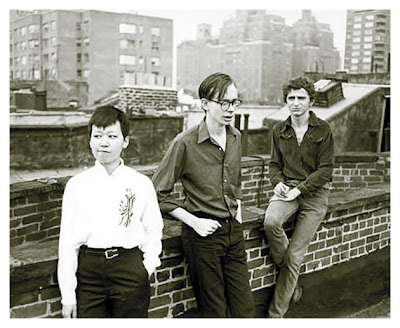
Where to begin ?
Ikue Mori arrived in New York from her native Tokyo at some point in 1977, quickly gravitating toward the CBGB's scene in downtown Manhattan. It was there, presumably, that she first encountered guitarist, Robert Quine.
In early 1978, Mori replaced Dublin born Gordon Stevenson in Arto Lindsay and Robin Crutchfield's DNA.

DNA, 1978: ikue mori; arto lindsay; robin crutchfield.
As the tiny No Wave movement gathered momemtum - disenchanted with the market forces which had descended on the Bowery - intermarriage and incest between localized tribes became rife. An open exchange of creative fluids.
Where one cell might bleed out, perish, mutation was a more likely prognosis.
Stevenson was invited by Lydia Lunch to play bass in Teenage Jesus and The Jerks. He accepted. Lindsay and Crutchfield instantly recruited Ikue Mori to sit in on drums for DNA. As it was, both bands appeared on the Brian Eno project, "No New York". Alongside The Contortions and Mars. Shortly thereafter, Crutchfield himself bowed out and was replaced by Tim Wright, formerly of the Cleveland incarnation of Pere Ubu.
Crudely painted at best, you get the picture. A petri dish seething with bacterial fermentation. As far removed from an irradiated desert as is imaginable.
DNA disbanded in 1982. Mori was drawn to collaborating with a sequence of experimental artists including Fred Firth, Tom Cora and John Zorn. She jettisoned traditional percussion in favour of a signature arrangement of three self-programmed drum machines. An evolution of the synthesized sound arguably pioneered in New York by Alan Vega and Martin Rev.

Bob Quine, of course, is no stranger On The Bleachers.
His work with a diverse range of artists through the eighties and nineties until his death in 2004 goes well beyond the remit of session musician. Or his tenure as Voidoid. By 1994 when he teamed up with fellow guitarist, Marc Ribot to revisit the landscape of Ikue Mori's "Painted Desert", Quine had previously worked with Zorn (and Frith) on 1985's "breakthrough" recording, "The Big Gundown". Itself a radical reworking of popular themes by Ennio Morricone.
Familiar territory. But stripped of the complex structure of Zorn's earlier project; the sheer weight of competing performance.
Recorded at Sear Sound, NYC, 14-16 February 1994.
Mixed by Joe Ferla at Sound On Sound, 24 July 1994.
Ikue Mori: Drum Programming;
Robert Quine, Marc Ribot: guitar;
Recorded by Alec Head. Produced by John Zorn.
▼ IKUE MORI: SANTA ANA EXCURSION from "Painted Desert" CD (Avant) 1997
▼ IKUE MORI: MEDICINE MAN from "Painted Desert" CD (Avant) 1997 (US)









3 comments:
Very good history here, ib. Not a huge No Wave fan except for James Black/White/Chance and ESG, but anything Quine-related piques my interest. There are some good No New York comps out there that highlight the movement pretty well. Sonic Youth I assume rode in at the tail end of the scene.
The whole No Wave (which ultimately culminated in my ears into Sonic Youth) left me cold.
Quine on the other hand... fucking genius.
Cheers, Warden.
According to Wiki, Thurston Moore organised The Noise Fest at the art space, White Columns in June '81. Sonic Youth made their first 'public' performance at this event.
While the whole No Wave thing was a singularly New York based phenomenon, Philadelphia band, Notekillers were doing their own bit for experimental noise back in 1978, releasing a single, "The Zipper b/w Clock Wise", and opening gig for Glen Branca at a gig during the same period.
Moore compiled their material on a retrospective CD released on his own Ecstatic Peace label a few years back. It still sounds amazingly fresh.
I featured Notekillers in a post a couple of years ago, after picking up on them originally through Mike's post over on Art Decade the year previously.
Rich:
Agreed as to Quine.
I was never deep into the No Wave scene, myself, although I appreciated the agitation and cohesion. After punk all but fizzled out and was appropriated as a fashion accessory.
By 1980, the music industry was at its most insufferable. No Wave was an antidote to that.
Post a Comment